Tuesday 27 November 2007
We take the 17.29
Intercity train from Rotterdam Centraal to Amsterdam Airport Schiphol where we
arrive 45 minutes later. We have already checked in for our flight with Austrian,
the Austrian airline, and we only have to drop off our luggage and receive our boarding card. We have dinner
in one of the terminal restaurants before we board the plane around 7.30pm. The
flight is uneventful and we arrive in Vienna around 9.30pm. We have to wait
quite a while for our luggage to arrive from the plane. Once we have them we
take the City
Airport Train (CAT), that takes us in less than 18 minutes (non-stop)
to Wien-Mitte (Landstraße) station. We bought and printed the tickets for
this train online, which is cheaper (and quicker) than buying them at the
station or on board the train. From the station we take a taxi to Hotel Urania.
A very short ride of less than 5 minutes. Meanwhile it has become 11pm, but we
want to have a drink before going to bed. The hotel has no bar, but walking
through the icy cold evening, we find one quite close. After a couple of
beers we head back to the hotel to enjoy a good night's sleep.
only have to drop off our luggage and receive our boarding card. We have dinner
in one of the terminal restaurants before we board the plane around 7.30pm. The
flight is uneventful and we arrive in Vienna around 9.30pm. We have to wait
quite a while for our luggage to arrive from the plane. Once we have them we
take the City
Airport Train (CAT), that takes us in less than 18 minutes (non-stop)
to Wien-Mitte (Landstraße) station. We bought and printed the tickets for
this train online, which is cheaper (and quicker) than buying them at the
station or on board the train. From the station we take a taxi to Hotel Urania.
A very short ride of less than 5 minutes. Meanwhile it has become 11pm, but we
want to have a drink before going to bed. The hotel has no bar, but walking
through the icy cold evening, we find one quite close. After a couple of
beers we head back to the hotel to enjoy a good night's sleep.
Wednesday 28 November 2007
Our room is a bit on the small
side, but nicely and individually furnished (modern four poster bed). Breakfast
and particularly the way it is presented is  not
up too much, but it is filling nevertheless. The owner and his staff are a bit
peculiar, but apart from that the place is OK. not
up too much, but it is filling nevertheless. The owner and his staff are a bit
peculiar, but apart from that the place is OK.
We walk to the underground (U-bahn)
station
Landstraße (at train station Mitte), where we buy a Vienna
Card. This is a pass for unlimited travel on public transport within
greater Vienna for 72 hours and also entitles to discounts on many museums and
tourist attractions. The card costs €18,50 and is valid from the first ride.
We take the U-bahn to Karlsplatz and walk to Operngasse for the box office
of the Federal Theatres (Bundestheatern), in order to collect our tickets for
tomorrow's opera performance at the Wiener Staatsoper. We booked the
tickets months ahead through the website of the Staatsoper
and even back then we were put on a waiting list. On the day of the show there
are tickets on sale for the standing room for only nine euros (!).
After collecting the tickets we
cross the street and go for coffee at café Sacher
, behind the opera building. Sacher is a Viennese institution, where the
original, but widely imitated, Sacher cake has been served for over more
than 175 years. The decor of this posh hotel and café is magnificent and the
service very attentive. From the extensive Viennese coffee menu we choose
a Wiener Melange (or just Melange as the Viennese call it), a sort of Viennese
cappuccino.
After the cake, which is a bit
heavy, we walk along the Ringstraße towards the Hofburg
, the grand town palace of the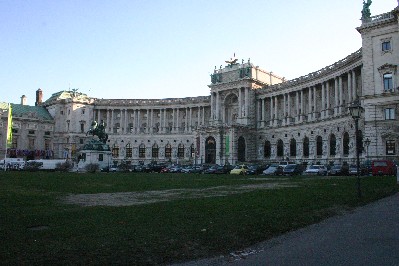 Habsburg imperial family. The first fortified building on this sport dates back
to 1275 when the Bohemian king
Otakar build a fortress here. He was beaten by the first Habsburg,
Rudolf I. It was not until the 16th century under emperor Ferdinand I, that
Vienna became the power base for the Habsburgs and the Hofburg was created. The
Hofburg is a complex of wings, courts and gates without a clear centre or main
entrance. A small part of the buildings is still in use by the Austrian
president. The buildings now house various museums and institutions. Best known
is the Schatzkammer
with the Habsburg crown jewels.The Wiener
Sängerknaben (Vienna Boys Choir)
perform weekly in the Hofburgkapelle and next door is the Spanish
Riding school, where the classic horse shows with the Lippizan horses
are held. Both companies have a complex schedule and getting tickets is a bit of
a rigmarole. We walk into the complex via the Burgtor from ±1820 commemorating
the Battle of Leipzig in 1813, where
Napoleon was defeated. We reach the Heldenplatz (Heroes square) in front of the Neue
Burg (New Fortress). This wing was built in 1913. Originally a mirror image
second wing was planned, thus forming a Imperial Forum, which would have been
linked by Triumphal Arches to the Court museums across the Ringstraße. It was
not to be. The finished wing was completed in 1926, 18 years after the Habsburgs
had left the scene. The Neue Burg now hosts a couple of museums and the reading
room of the Nationalbibliothek. The Heldenplatz is known for Adolf
Hitler's speech he gave here in 1938 celebrating the
“Anschluß” (link-up) of his home country Austria to the German Empire. He
was cheered by an enthusiastic Viennese crowd. In front of the Neue
Burg stands the equestrian statue of Prince Eugene of Savoy, the army leader who
defeated the Turks in 1628, thus ending their siege of Vienna. The prince was
refused a military post earlier by the French court, maybe because of his
preference for relationships with men. We walk along the Hofburg chapel and get
to In
der Burg (inside the fortress), the 18th century part of the
complex. On the right we see the Schweizer Tor (Swiss gate), leading to the Alte Burg
(old fortress) the heart the complex. On the gate, dedicated to Ferdinand I
is a list of the many countries (Germany, Austria, Hungary, Bohemia, Spain and
Burgundy) under Habsburg rule. It
finishes with a “ZC” which means et cetera. On In
der Burg are the entrances to the Schatzkammer and the Kaiserappartments
(Imperial apartments). What follows is the Michaelertor (Michael's gate), a
gigantic gate, crowned by a copper clad dome. Inside the gate is the entrance to
the Sisi-museum, dedicated to empress
Elizabeth, the famous and beloved wife of Franz-Josef I, enjoying something of a
cult status.
Habsburg imperial family. The first fortified building on this sport dates back
to 1275 when the Bohemian king
Otakar build a fortress here. He was beaten by the first Habsburg,
Rudolf I. It was not until the 16th century under emperor Ferdinand I, that
Vienna became the power base for the Habsburgs and the Hofburg was created. The
Hofburg is a complex of wings, courts and gates without a clear centre or main
entrance. A small part of the buildings is still in use by the Austrian
president. The buildings now house various museums and institutions. Best known
is the Schatzkammer
with the Habsburg crown jewels.The Wiener
Sängerknaben (Vienna Boys Choir)
perform weekly in the Hofburgkapelle and next door is the Spanish
Riding school, where the classic horse shows with the Lippizan horses
are held. Both companies have a complex schedule and getting tickets is a bit of
a rigmarole. We walk into the complex via the Burgtor from ±1820 commemorating
the Battle of Leipzig in 1813, where
Napoleon was defeated. We reach the Heldenplatz (Heroes square) in front of the Neue
Burg (New Fortress). This wing was built in 1913. Originally a mirror image
second wing was planned, thus forming a Imperial Forum, which would have been
linked by Triumphal Arches to the Court museums across the Ringstraße. It was
not to be. The finished wing was completed in 1926, 18 years after the Habsburgs
had left the scene. The Neue Burg now hosts a couple of museums and the reading
room of the Nationalbibliothek. The Heldenplatz is known for Adolf
Hitler's speech he gave here in 1938 celebrating the
“Anschluß” (link-up) of his home country Austria to the German Empire. He
was cheered by an enthusiastic Viennese crowd. In front of the Neue
Burg stands the equestrian statue of Prince Eugene of Savoy, the army leader who
defeated the Turks in 1628, thus ending their siege of Vienna. The prince was
refused a military post earlier by the French court, maybe because of his
preference for relationships with men. We walk along the Hofburg chapel and get
to In
der Burg (inside the fortress), the 18th century part of the
complex. On the right we see the Schweizer Tor (Swiss gate), leading to the Alte Burg
(old fortress) the heart the complex. On the gate, dedicated to Ferdinand I
is a list of the many countries (Germany, Austria, Hungary, Bohemia, Spain and
Burgundy) under Habsburg rule. It
finishes with a “ZC” which means et cetera. On In
der Burg are the entrances to the Schatzkammer and the Kaiserappartments
(Imperial apartments). What follows is the Michaelertor (Michael's gate), a
gigantic gate, crowned by a copper clad dome. Inside the gate is the entrance to
the Sisi-museum, dedicated to empress
Elizabeth, the famous and beloved wife of Franz-Josef I, enjoying something of a
cult status.
Leaving the Hofburg we walk
onto Michaelerplatz and are faced with the Loos Haus. A larger contrast
is hard to imagine. Across from the (neo) baroque pomp of the palace, architect Adolf Loos
created in 1909-11 an austere modern building, without any ornamentation around
the windows. A storm of protest erupted and the emperor bemoaned the view on the
house without eye brows. As a compromise Loos thought of flower banks under the
windows. On the ground floor the building has classical elements like
columns.
We walk onto the Herrengasse
until the Freyungspassage, linking the Herrengasse with the Freyung
square. It is an elegant shopping mall from  1866, nicely restored to its former glory. The Freyung is a large
haphazard square around the Austria-fountain. The 4 nymphs represent four
important rivers of the empire in those days: Danube, Po, Elbe en Vistula. The
square is also home to the Schottenkirche, part of the former monastery
Schottenstift. The monastery was founded in the 11th century and was
run by Irish (and not Scottish) monks. The monastery is no more, but the grammar
school for boys (Schottengymnasium) is still a prestigious secondary school.
Right now the square is the scene for one of the many yearly Christmas markets (Christkindlmarkt). Via
the Minoritenplatz and the
Schauflergasse we get back to Michaelerplatz. We take a look in the Michaeler
Kirche . It was originally a 13th century gothic church. Inside
the falling angels above the high altar are especially worth a look and also the
gold plated organ - the biggest baroque organ in Vienna - is very nice.
1866, nicely restored to its former glory. The Freyung is a large
haphazard square around the Austria-fountain. The 4 nymphs represent four
important rivers of the empire in those days: Danube, Po, Elbe en Vistula. The
square is also home to the Schottenkirche, part of the former monastery
Schottenstift. The monastery was founded in the 11th century and was
run by Irish (and not Scottish) monks. The monastery is no more, but the grammar
school for boys (Schottengymnasium) is still a prestigious secondary school.
Right now the square is the scene for one of the many yearly Christmas markets (Christkindlmarkt). Via
the Minoritenplatz and the
Schauflergasse we get back to Michaelerplatz. We take a look in the Michaeler
Kirche . It was originally a 13th century gothic church. Inside
the falling angels above the high altar are especially worth a look and also the
gold plated organ - the biggest baroque organ in Vienna - is very nice.
We walk onto the Kohlmarkt, one
of the poshest shopping streets in the city, with beautiful shops. A fair number
still sports the K&K (Königlich
und Kaiserlich; Royal and Imperial) livery as if the republic was never
declared. From the Kohlmarkt
we have a picture frame view of the Michaelertor and the Hofburg. Kohlmarkt
leads to Graben.
This is a much wider shopping street, but no less prestigious. We turn off Graben
into Dorotheergasse to step inside another Viennese institution: Tresniewski.
This lunch counter sells small slices of bread covered with spreads of egg, meat
or fish, washed down by the locals with a Pfiff, a tiny glass of beer. Outside
the place is very inconspicuous. You could easily pass it without
noticing. Graben.
This is a much wider shopping street, but no less prestigious. We turn off Graben
into Dorotheergasse to step inside another Viennese institution: Tresniewski.
This lunch counter sells small slices of bread covered with spreads of egg, meat
or fish, washed down by the locals with a Pfiff, a tiny glass of beer. Outside
the place is very inconspicuous. You could easily pass it without
noticing.
Via Graben we walk past the Pestsäule
from 1679. The column was erected celebrating the victory over the pest
epidemic. We also see the Peterskirche from 1708 by the
architect Hildebrandt, one of the best baroque churches in central Vienna.
We now reach Stock-im-Eisenplatz. On the corner of the Equitable building is a
piece of larch tree, into which - according to tradition - all Viennes blacksmith
apprentices have to drive a nail. Next stop is the Stephansplatz,
unmistakably the heart of the inner city. The big Stephansdom
cathedral dominates the square. We go inside, but we cannot go beyond the front
porch, because a mass is going on. We walk a small circuit around the square and
see the Figaro house, where Mozart lived a couple of years and
composed La Nozze di Figaro. We eat in Bizi a sort of self
service Italian deli. Very popular. After lunch we return to the cathedral. We
look around the church, with its very nice pulpit and take a ride up the Pumerin,
the north (bell)tower by elevator. The south tower is also accessible, but only by a
staircase. The views are nice, especially of the colourful mosaic roof tiles of
the church. It depicts the city emblem and the year of the church reconstruction
after its destruction in World War II. 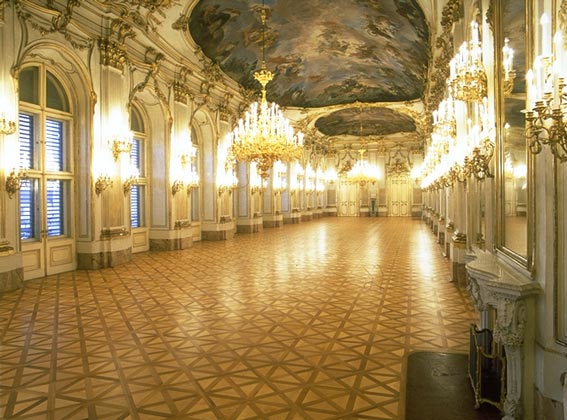
Back on the ground we take the
underground to Schönbrunn, the
summer palace of empress Maria Theresia
(1740-80). This palace was Austrias answer to 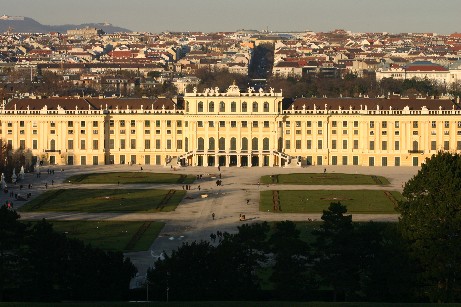 Versailles. Inside the palace we choose the Imperial Tour. This is a self guided
tour with an audioguide through the most important rooms of the palace. The
rooms are magnificent. A lot of attention is given to the rooms once used
by Franz Josef I and Elizabeth (SiSi), but also Maria Theresia gets a fair
bit of attention. The Grand Gallerie was the meeting place of Kennedy and
Khrutchev in 1961. The tour lasts about 35 minutes and takes us through 22
rooms in the west wing and the central part. The Grand
Tour lasts 50 minutes and covers all 40 rooms, including the east wing. After
the palace we take a look at the formal gardens. It is a bit of climb to the
Glorietta, a pavilion on a hill overlooking the palace, the gardens and the
city. The weather is perfect. It is sunny and clear and wintry cold.
Versailles. Inside the palace we choose the Imperial Tour. This is a self guided
tour with an audioguide through the most important rooms of the palace. The
rooms are magnificent. A lot of attention is given to the rooms once used
by Franz Josef I and Elizabeth (SiSi), but also Maria Theresia gets a fair
bit of attention. The Grand Gallerie was the meeting place of Kennedy and
Khrutchev in 1961. The tour lasts about 35 minutes and takes us through 22
rooms in the west wing and the central part. The Grand
Tour lasts 50 minutes and covers all 40 rooms, including the east wing. After
the palace we take a look at the formal gardens. It is a bit of climb to the
Glorietta, a pavilion on a hill overlooking the palace, the gardens and the
city. The weather is perfect. It is sunny and clear and wintry cold.
We take the underground back to
the hotel for a short break. Then we are on our way to the Sezession near
Karlsplatz. Here we meet Wolfgang, a Viennese friend of a friend of ours from
Düsseldorf.
He takes us to the Naschmarkt, the deli market of Vienna. Apart
from market stalls with all thinkable fresh local and foreign food, there a
quite a number of little restaurants of all sorts. We have a glass of wine in a Vinotek
and have an Asian dinner at Li’s Kitchen. Good food and quickly served. Wolfgang
takes us to Karlsplatz for a Punch (warm Viennese Christmas drink) on the
Christmas market. It is very busy, with people chatting away while enjoying
their drinks. Wolfgang says goodbye and we are off to Café Savoy (traditional)
and Felixx bar (trendy), two gay bars in the area.
Weather: 4 degrees and sunny
Thursday 29 November 2007
After breakfast we start
looking for a café nearby for some Viennese coffee. We take tram N to café Zartl. We
order both an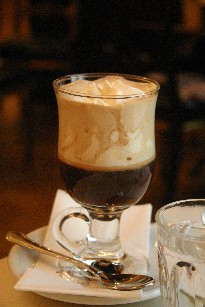 Einspänner. Viennese coffee in a glass with large portion of Schlagobers (whipped
cream) on top. Just ordering coffee is greeted with bewildered frowns here in
Vienna. Viennese self respecting cafés have a long menu of different coffee
varieties (large, small, strong, weak and milky or with whipped cream, with or
without liqueur or combinations of the before mentioned). Coffee was introduced
in Vienna after the victory on the Turks breaking siege in 1683. When the Turks
were defeated and chased away, large stocks of the Turks' coffee fell into the
hands of the Imperial troops. After our coffee we walk to the Hundertwasserhaus.
In the 1980's the Austrian artist Friendensreich Hundertwasser got the commission
by the city council to cheer up a block of dreary council flats in the
Landstrasse district. It has become a mishmash of pilasters, balconies and an
overdose of curves and colours. The architectural world was all over him, but
tourist came in droves, much to the dismay of the occupants who became weary of
the many people ringing the doorbell asking for a show of their apartment.
This is why
Hundertwasser designed a shopping mall across the street called Hundertwasser
village, where he could yet again have his way with his bizarre designs. The
shops inside sell mainly general Viennese souvenirs. One shop sells
reproductions of Hundertwasser's paintings. Hundertwasser has a penchant for
uneven floors, so we have to be careful with our steps. We take a tram and
another tram to the Belvedere This is the palace especially built for Prince Eugene of
Savoy. The prince was successful in fighting off the Turks during the siege
of 1683. Thanks to his victories Vienna could at last expand beyond the walls of
the inner city. The complex consists of two palaces. The lower or Unteres Belvedere,
is actually no more than an oversized garden house and the actual palace the
upper or Oberes Belvedere, lies somewhat uphill on the other end of
the formal gardens. The
Unteres Belvedere, lived in by Eugene for his personal use (the parties
and receptions took place
Einspänner. Viennese coffee in a glass with large portion of Schlagobers (whipped
cream) on top. Just ordering coffee is greeted with bewildered frowns here in
Vienna. Viennese self respecting cafés have a long menu of different coffee
varieties (large, small, strong, weak and milky or with whipped cream, with or
without liqueur or combinations of the before mentioned). Coffee was introduced
in Vienna after the victory on the Turks breaking siege in 1683. When the Turks
were defeated and chased away, large stocks of the Turks' coffee fell into the
hands of the Imperial troops. After our coffee we walk to the Hundertwasserhaus.
In the 1980's the Austrian artist Friendensreich Hundertwasser got the commission
by the city council to cheer up a block of dreary council flats in the
Landstrasse district. It has become a mishmash of pilasters, balconies and an
overdose of curves and colours. The architectural world was all over him, but
tourist came in droves, much to the dismay of the occupants who became weary of
the many people ringing the doorbell asking for a show of their apartment.
This is why
Hundertwasser designed a shopping mall across the street called Hundertwasser
village, where he could yet again have his way with his bizarre designs. The
shops inside sell mainly general Viennese souvenirs. One shop sells
reproductions of Hundertwasser's paintings. Hundertwasser has a penchant for
uneven floors, so we have to be careful with our steps. We take a tram and
another tram to the Belvedere This is the palace especially built for Prince Eugene of
Savoy. The prince was successful in fighting off the Turks during the siege
of 1683. Thanks to his victories Vienna could at last expand beyond the walls of
the inner city. The complex consists of two palaces. The lower or Unteres Belvedere,
is actually no more than an oversized garden house and the actual palace the
upper or Oberes Belvedere, lies somewhat uphill on the other end of
the formal gardens. The
Unteres Belvedere, lived in by Eugene for his personal use (the parties
and receptions took place 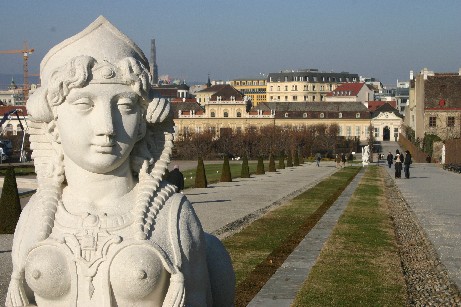 in the Oberes Belvedere), is now a museum for mainly 17th and 18th
century Austrian art. But today there is a special exhibition called Wien-Paris,
linking French and Austrian painters between 1880 and 1950, notably
impressionists, pointillists and some fauvists. The palace itself is a sight in
its own right. Especially the Marble Room with a magnificent fresco depicting
Prince Eugene himself as Apollo. The Groteskensaal with a grotesk decor of birds
and other animals is very special. The style was inspired by Roman art found
during excavations. Those rooms looked like "grottos" and the style
was therefore called "grotesque". It bit further down is the Goldkabinett, a mirror room from
the days of Maria Theresia.
in the Oberes Belvedere), is now a museum for mainly 17th and 18th
century Austrian art. But today there is a special exhibition called Wien-Paris,
linking French and Austrian painters between 1880 and 1950, notably
impressionists, pointillists and some fauvists. The palace itself is a sight in
its own right. Especially the Marble Room with a magnificent fresco depicting
Prince Eugene himself as Apollo. The Groteskensaal with a grotesk decor of birds
and other animals is very special. The style was inspired by Roman art found
during excavations. Those rooms looked like "grottos" and the style
was therefore called "grotesque". It bit further down is the Goldkabinett, a mirror room from
the days of Maria Theresia.
In the upper or Obere Belvedere
is large collection of Austrian modern artists. Especially Klimt and his pupil
Schiele are well represented. Klimt seems to have been the favourite artist of
his days in Vienna. We see long series of portraits he made of society women in
Vienna. Best known are "Judith I” and “The Kiss”, in which he himself
is seen in an embrace with his muse. Both paintings are from his golden period.
This palace too, has a Marble Room. This one is lighter and with red marble. In
this room the Austrian State Treaty was signed in 1955, ending the occupation of
Austria by the allies and returning sovereignty to Austria under the condition
of neutrality. The western wing of the palace shows much more traditional work,
among which many historic and realist works from the 19th century. Famous is the
painting of Napoleon in the St Bernhard pass by Jacques-Louis David, which is
supposed to be on display in the Untere Belvedere.
After the Belvedere we walk to
via the Russian war memorial to Karlsplatz to have a look at the Karlskirche.
It is a baroque church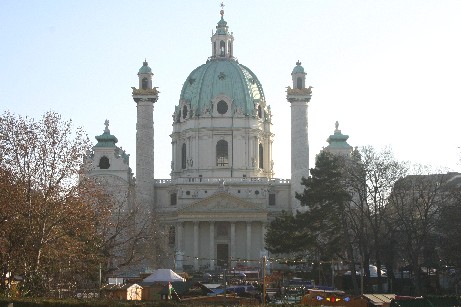 , built for emperor Karl VI by Johan Bernhard Fischer von Erlach and
finished in 1737. The church has an Italianate dome and decorative pillars
representing imperial power. On the square are also two Art Nouveau or
Jugendstil pavilions, that used to serve as entrances to the underground.
The were designed by the Viennese architect Wagner. One of them is now a tea
room.
We walk to the Wiener Secession.
This is an art institute founded by artists who split away in the late 19th
century from the Wiener Künstlerhaus. The building is the most authentic Jugendstil
building in Vienna and was completed in 1899 by Joseph Maria Olbrich. Most striking , built for emperor Karl VI by Johan Bernhard Fischer von Erlach and
finished in 1737. The church has an Italianate dome and decorative pillars
representing imperial power. On the square are also two Art Nouveau or
Jugendstil pavilions, that used to serve as entrances to the underground.
The were designed by the Viennese architect Wagner. One of them is now a tea
room.
We walk to the Wiener Secession.
This is an art institute founded by artists who split away in the late 19th
century from the Wiener Künstlerhaus. The building is the most authentic Jugendstil
building in Vienna and was completed in 1899 by Joseph Maria Olbrich. Most striking  is the ball of gold plated trea leaves on the roof
(“golden cabbage”) and the marble walls with typical decorations (owls, a
trio of gorgons, a couple of salamanders and lots of gilded foliage) and
texts.
Inside the building comtemporary art exhibitions are held. The Beethoven
Fries by Klimt is on permanent display. We have lunch near the Naschmarkt. After
lunch we take the underground to the Prater, the vast recreational
forest in the Leopoldstadt district. We go for the famous Ferris Wheel or Riesenrad
from 1897, built to celebrate the jubilee of emperor Franz Josef I. A ride
is one of those "must do" things whilst in Vienna. The wheel has no seats but
small cottages, holding 12 people. Very slowly the cottage moves to the top with
lots of stops for letting people on or off. The wheel is also known from the
movie
is the ball of gold plated trea leaves on the roof
(“golden cabbage”) and the marble walls with typical decorations (owls, a
trio of gorgons, a couple of salamanders and lots of gilded foliage) and
texts.
Inside the building comtemporary art exhibitions are held. The Beethoven
Fries by Klimt is on permanent display. We have lunch near the Naschmarkt. After
lunch we take the underground to the Prater, the vast recreational
forest in the Leopoldstadt district. We go for the famous Ferris Wheel or Riesenrad
from 1897, built to celebrate the jubilee of emperor Franz Josef I. A ride
is one of those "must do" things whilst in Vienna. The wheel has no seats but
small cottages, holding 12 people. Very slowly the cottage moves to the top with
lots of stops for letting people on or off. The wheel is also known from the
movie 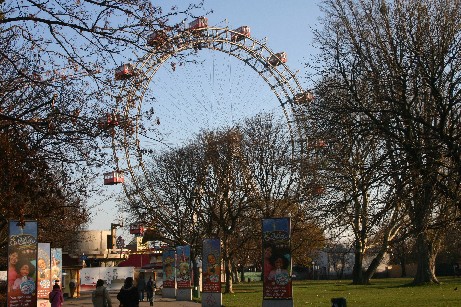 The Third Man. In front of it Orson Welles, does his “cuckoo's clock
speech” before he disappears again. After the ride on the ferris wheel and the
beautiful view, we take the tram to the hotel.
The Third Man. In front of it Orson Welles, does his “cuckoo's clock
speech” before he disappears again. After the ride on the ferris wheel and the
beautiful view, we take the tram to the hotel.
We change clothes for our
visit to the opera. Before that we have dinner in an Italian restaurant Iragazzi
on Burggasse in the Josefstadt district. We then walk to the opera house.
We are about to see and hear l’Elisir d’Amore (Love Potion) by Donizetti the
Wiener Staatsoper
.The building is magnificent. The foyer with its staircases, statues and frescoes
is very stylish indeed. The opera was the first public building that was
completed on the Ringstraße was opened in 1869. The design is by the architectural
couple
Eduard van der Null and August Sicard von Sicardsburg. The building was much
critisised at the time, because the street level of the Ringstrasse had not been
taken into account, which is why the opera's ground level is about 1 meter
to low. Van der Null took the critique too hard and he committed suicide before
the opening in 1868. His partner followed him in the grave within 10 weeks dying
from a "broken heart". In the theatre we are on row 11. The walls of
the theatre are formed by the numerous boxes. There is als standing room at the
back of the floor of the theater and above the boxes. The production is very
traditional and of high quality. There is a small screen for every spectator,
with the translation in either German or English. After the performance we go
for some
Prosecco and a bite from a "Gran Piatto" with goodies in Wein+Co
, a popular wine bar on the Getreidemarkt, next to the Secession building.
Weather: 2°C and sunny
|


 only have to drop off our luggage and receive our boarding card. We have dinner
in one of the terminal restaurants before we board the plane around 7.30pm. The
flight is uneventful and we arrive in Vienna around 9.30pm. We have to wait
quite a while for our luggage to arrive from the plane. Once we have them we
take the
only have to drop off our luggage and receive our boarding card. We have dinner
in one of the terminal restaurants before we board the plane around 7.30pm. The
flight is uneventful and we arrive in Vienna around 9.30pm. We have to wait
quite a while for our luggage to arrive from the plane. Once we have them we
take the 